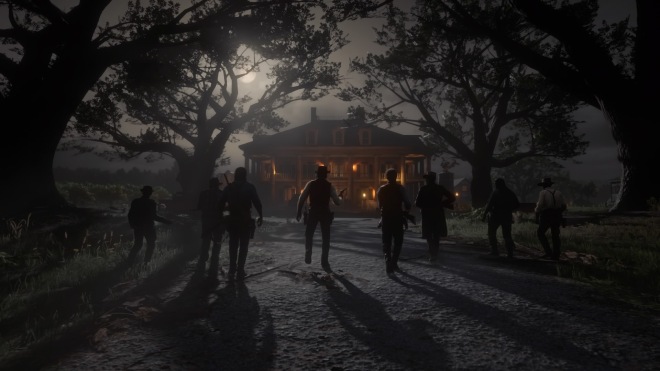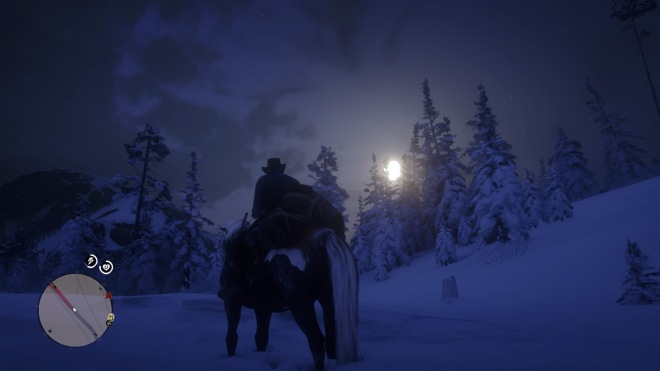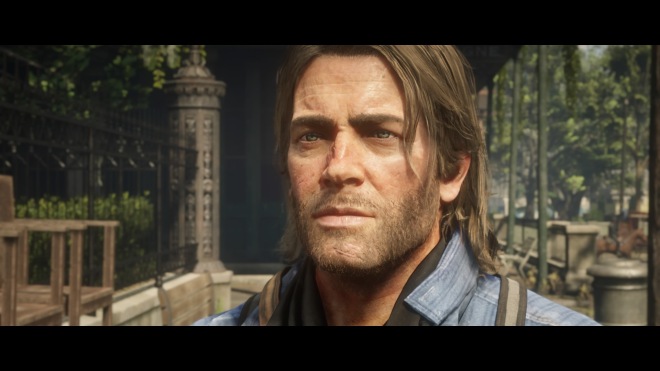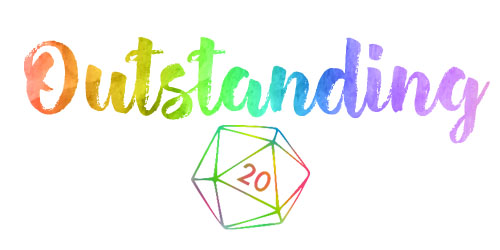Red Dead Redemption 2 (2018)
Rockstar Studios | Reviewed on PS4

Riding into the sunset
Exactly one year ago, on October 26, 2018, the much anticipated sequel to Rockstar’s critically acclaimed cowboy adventure, Red Dead Redemption 2, was released. In true meghanplaysgames fashion, my review is about a year overdue, but time is an illusion, so here we are. I absolutely loved the first Red Dead Redemption – I obsessed over that game for months, completing every challenge, side quest, and my personal favourite, fleecing fools in the local saloon at liar’s dice (seriously, I made bank off of those games). I was extremely excited for the sequel, and while I got off to a rough start with this title, it quickly grew on me. I ended up enjoying this just as much as the original game. Red Dead Redemption 2 manages to be both novel, and occasionally, exceptionally dull (much like I imagine the real ol’ west probably was) in its presentation of its living, breathing world, and in its excessively detail-oriented and slow-paced gameplay. I’ve separated my review for Red Dead Redemption 2 (henceforth, RDR2) into sections, based on my favourite and least favourite aspects of the game: the good, the bad, and the ugly. Because that seems like the yeehaw thing to do. I also feel obligated to mention that this review will be full of spoilers. So grab your cowboy hat and saddle up for a good old fashioned slice of the lawless, languid western life.
The Good

There are two main elements of gameplay that RDR2 pulls off exceptionally well: its characters, and its exploration, or world-building, if you will. When I played the original Red Dead Redemption, I was so invested in protagonist John Marston, I was convinced that no other game would be able to top his character for me. I loved the balance between his hostile, sarcastic attitude when dealing with clowns like Nigel West Dickens and Irish, and the obvious heart of gold he showcased when helping someone out simply because he happened to be there. It was a classic tale of, well, redemption. And yet, RDR2’s protagonist, Arthur Morgan, was just as good, if not even better, than the original game’s cowboy. If I’m being honest, I didn’t really like him at first – the game really leans into his hickness, with other characters constantly reminding him that he is a) stupid and b) only useful as the gang’s muscle. His voice in particular I found grating initially. However, as the narrative progressed, and Arthur began to question the life he has cultivated for himself – both its morality, and his loyalty to the other members of his pseudo-family – he started to grow on me. His casual sass when roasting other members of the posse, and genuine attempts to change his behaviour and rectify his past mistakes made me fall in love with his character. I particularly liked his everyman persona; he’s not the smartest, nor the boldest, but his entire life has been built around the outlaw life, and his experience makes him indispensable. I also enjoyed the huge variety of customization options for this character. It was nice knowing that everything from my shirt, to my gun could be unique, and that my version of Arthur would be different from everyone else. His father-son relationship with John Marston’s son, Jack, is absolutely adorable, and this mentorship extends to several other members of the gang, like Lenny. It was enjoyable to see such a multi-faceted protagonist. I’m sure I’m not alone in saying that I cried at the end of Arthur’s tale; I’d grown so attached to his character, and I was devastated to see him meet his end.

The other characters that drive the narrative are also handled well, and given enough personality and life to become invested in. My favourites were Sean, the young Irish scamp, Lenny, talented, and desperate to prove his worth, and Sadie, the widow on a quest for revenge. John is a given – I appreciated that more of his backstory was fleshed out in this game, giving his character a more rounded arc to set up the story of the original game. Dutch van der Linde, leader of the posse, is possibly one of my favourite villains of all time. He’s built up so well throughout the course of this narrative, starting out as the dynamic and charismatic leader that any member would die for, before slowly twisting and devolving into the spineless, shell-of-a-con-man that we see at the end of Red Dead Redemption. His character is classic in a lot of ways – he reads philosophy and has an over-inflated sense of his own intellect (which he takes very seriously, and god help the man who dares to insult it, as seen with Angelo Bronte) which he flaunts constantly. He enjoys his leadership position, and is visibly incensed whenever he catches a flicker of disloyalty from a character questioning his decisions (particularly Arthur). He is also every bit the charlatan and primitive crook that he claims to be above – I think its pretty clear he doesn’t wholly believe the gentleman-thief-Robin-Hood tale that he spins to his followers, but like all good con-men, his conviction is just strong enough to sell the well-packaged narrative to the gang. He is deeply flawed, and deeply human, and its satisfying to see his regression from the untouchable, all-knowing leader, to the rat coward who abandons his family. And yet, he still feels a sense of loyalty, or maybe obligation, towards John in the end. He’s a fascinating, and extremely well-written character. Micah, on the other hand, is much more cartoonishly evil; he’s a terrible person and does terrible things for the hell of it, and yet, I still completely bought into his character. By the end of the game, I wanted nothing more than to put a bullet in his skull.

Along with the characters that shape your journey, there is also the land itself, and by George (or Gavin?), there is a lot of it. The map for RDR2 is absolutely massive, made all the more so by the lack of fast travel options. I personally didn’t mind this, but I know that taking 5 or 10 minutes to simply ride to a certain mission or town won’t be appealing to everyone. I actually enjoyed feeling like I needed to prepare – appropriate clothing, food, ammo, etc – before I started out on a ride; it made me feel like I was setting out on a proper journey. RDR2 also sees a huge improvement from the original in its horses – pretty important, considering they are going to be your main mode of transportation, and realistically, your best friend. In this title, you can take care of your animal by feeding and brushing them, as well as customizing their manes, tails, and saddles. They’re also a lot sturdier in this game; I remember in the original Red Dead Redemption, the horses were fragile enough to constitute being weapons in Breath of the Wild. Because you’re getting much more attached to your horse in RDR2, I’m glad they made them a lot heartier. I spent most of the game with my Missouri Fox Trotter, Artax, but also had a few others that I’d grown attached to in the stables. But the greatest achievement of RDR2’s immersive world is the sheer variety of things to do. It truly felt like a world that existed on its own, outside my character; there was always something to do, or something to see. I didn’t enjoy the hunting too much, because that’s not me, but the exploration and social aspects were unparalleled. During my countless rides across the vast landscape, I would encounter some kind of excitement – whether it was a lady by the side of the road, asking for a ride into town, or a man being chased by a mountain lion. Pull up a log to the camp fire and open a tin of beans, it’s Story Time™:
As I walk by the gunsmith in Rhodes one night, I hear a man calling to me from a small basement window beneath the shop. He claims the owner is holding him hostage, treating him as his ‘son’ and he needs my help. Curious, I enter the shop, and question the owner; he denies any wrongdoing. I point my gun at him and force him to lead me downstairs. He does. The basement is decorated in toys, and clearly made for a young child. The man whose been imprisoned for who knows how long thanks me, and takes off. I hogtie the owner and dump him on the small children’s cot that his prisoner has been using, and leave (after taking all the merchandise I can hold of course). Not for the first time since starting the game, I walk away completely in awe.

I’ve never played another game that feels this alive – where random, happenstance events are playing out around every corner; where a simple interaction can quickly spiral into a mystery, or an overheard conversation can lead to a new discovery. I remember overhearing the drunk preacher, Reverend Swanson, talking about seeing the ghost of a woman in white in the nearby swamp. I didn’t think much of it – until I encountered her several nights later while approaching a stranger mission. I returned every night for almost a week, trying to figure out the time and place she appeared, in order to listen to her monologue. I nearly got eaten by alligators about 30 times, but it was worth it. Speaking of Bluewater Marsh, aka the most terrifying area in the entire game, its one of the most interesting to explore. There are random zombie-like swamp people, bodies hanging from trees, strange symbols painted everywhere, and bloody alligators every 3 feet. If I hadn’t committed to exploring a certain section, there was a zero percent chance that I would be spending time there. Each time I had to ride through (especially at night) I’d be going absolutely full tilt, no slowing or stopping. Oh, a crying woman off in the trees? Not today lady, nice try.
Another event that plagued me throughout the entire game was the mystery of the serial killer. I stumbled across a torso tied to a tree down near Rhodes with a section of map, and a message left behind: Behold. I quickly became obsessed with finding the remaining pieces of the puzzle, but didn’t manage to do so until the game was nearly over. Regardless, I was able to track down the serial killer, and turn him over to the law. Sort of. I also spent more time than I am publicly willing to admit trying to find the messages scrawled on the walls around Saint Denis (I finally caved and had to look up the location of the last two). This lead me to an encounter with a vampire, of all things. You know, as per. I love the inclusion of supernatural elements in these games – it makes for exciting mysteries, and surprising “rewards.” Regardless, whether I was sweating nervously in a section of forest, convinced I could hear whispers all around me, or just searching for landmarks that Arthur would sketch in his notebook, I can honestly say this is the best open world I have ever had the pleasure of spending time in. I have a million more stories of encounters I had while exploring, and yet, I know I’ve barely scratched the surface of everything this game has to offer. I’m happy to wile away hours and hours simply riding around, howdy-ing at everyone I pass, and maybe stumbling across a secret or two.

I’m hesitantly including the narrative of RDR2 in my “Good” section, though in and of itself, the story of this title is not especially strong. The structure was the main cause of the narrative suffering in my opinion; while the chapters created clear breaks between important moments, and clearly showcased the slow breakdown of the gang, there was a lack of overarching goals driving the story forward. In the original Red Dead Redemption, John has to kill his old gang members in order to receive his pardon, and get his family back. No matter what ridiculous shenanigans you got up to, those goal posts were always on the horizon. With the death of each gang member, you inched closer to that end. In RDR2 however, there is no overarching story or goal – only the vaguest “we need to make a lot of money and disappear” is ever presented. A chapter would usually end with events that would cause the gang to move to a new camp, and the cycle would begin again: try to find work, find yourself in deep shit, move on. It got repetitive, and with no obvious end-game in sight, I found myself somewhat uninterested in what was going on. The characters and their fates are truly what kept me engaged with the game and pushing forward. They end up carrying the story, which isn’t inherently bad, but if structured differently, could have been a lot better.
The Bad

The gameplay in RDR2 feels dated, and this ties directly into the missions being a little lackluster. Coming to RDR2 after playing Marvel’s Spider-Man was a nightmare in the beginning; after the fast and fluid gameplay of that title, playing this one felt awful in comparison. The pace was glacial, and everything felt heavy and clunky. It was something I got used to after a few hours with the game, but initially, it drove me nuts. It controls almost exactly like Red Dead Redemption, which is now about 10 years old, and a lot of the missions feel similar to the original as well. There are a lot of “ride here, shoot em up, and ride home” sequences, as well as a lot – A LOT – of wagon driving, horse riding, and chatting. When the missions are good, as in The Battle of Shady Belle, where you raid the Bronte’s mansion in search of John’s kidnapped son, they are really good. But when they’re bad, they can feel dull, repetitive, and tired. This slow burn style isn’t going to be for everyone, but I found it to be generally tolerable.
My other main gripe with the game was the lack of freedom during said missions. I remember one specific instance when, as I walked away from my horse, I realized I had left my rifle on my mount (a somewhat annoying mechanic they added, where most of your guns are stored until you take them out) and walked back to retrieve it. I walked about 10 feet away from my partner (I think it was Javier) and back to my horse, whereupon I automatically failed the mission for straying too far. I was baffled, and this lead to later frustrations where I didn’t want to try anything creative, lest I be punished for it. I found myself in another situation, quite a bit further into the game, where I’d been kidnapped by our rival gang, the O’Driscolls. When you free yourself, a mission objective pops up, implying you need to sneak out of the camp without being seen – which is exactly what I did. When I completed the mission, and viewed my success checklist (each mission has optional objectives, completing some or all of which will earn you a bronze, silver, or gold rating) I see that I actually had the option to shoot my way out, and murder every single enemy in the camp. It was frustrating not knowing what exactly the game would permit, and what it would not, and to unknowingly miss objectives for erring on the side of caution. Damn O’Driscolls.

My final comment on the Bad: the Cuba chapter. In this chapter, Arthur, Dutch, Javier, and Bill (funnily enough, the members that you hunt down in the original game) are stranded on Guarma, and must find a way back to the gang. I’ve thought a lot about this section of the game, and whether I thought it was necessary or not. Ultimately, I think this chapter is a waste of time. While it does present some important narrative revelations, where Arthur finally realizes who Dutch truly is, and his illness begins to present itself, it feels superfluous. I also liked the implication that this “tropical escape” (TAHITI!) that Dutch is also banging on about doesn’t exist, but again, it feels unnecessary. This is nothing that couldn’t have been established in the scope of the regular game. You can’t do much exploring in this area, and characters are introduced that aren’t important to the narrative, and that we will never see again. In a game that is already arguably overlong, this chapter felt like additional padding to the length. Though it culminates in an impactful, cinematic ride back to your squad when you return (probably one of my favourite moments of the game) it still didn’t do enough to establish itself as a crucial branch for the narrative.
The Ugly

I’m using this section to discuss a couple of points that stood out as pretty god awful. Firstly, as is fairly on brand for Rockstar games, the social issues present in RDR2 are handled with about as much nuance and subtlety as a dwarf in full plate armor. I’m not going to spend a lot of time talking about this issue, as I’m not an expert, nor am I in a position to be saying how it should have been done, but the way the Native Americans are treated is pretty abysmal. There were a couple lines of dialogue that made me cringe – especially one where their plight (losing their land, and being systematically murdered) is compared to that of the outlaws being forced to abandon their way of life. These issues are complex, and Rockstar never gives them the attention and care that they need to be represented fairly. It was the same in the original game, and is just as poor here.
Secondly, it’s strange that in a game about being an outlaw, you would be punished so heavily for actually acting like one. There is quite literally no point of trying to be anything other than the noble, white-knight cowboy, because this game makes it damn near impossible with the way it responds to your criminal activity. If you do any kind of evil (yet extremely fun) deeds, like robbing trains, lassoing dames and putting them on the tracks, holding up a store or a bank. or anything remotely outlaw-ish, you will instantly have about 9000 lawmen on your ass. I’m not convinced that GPS tracking and advanced optometry didn’t exist in this version of the wild west, because they all inexplicably know your exact location, and can spot you from about 80 miles off. You’ll have gunfire rained upon you (you might have about 10 seconds to either surrender or negotiate before they start shooting) from every angle, and you’ll be dead in mere minutes. Fleeing is pointless, as they will continuously spawn and pursue you endlessly. I remember one specific incident in Saint Denis when I bumped into a lady while riding by on my horse, and a cop happened to be standing there. He immediately pointed his gun at me, and as I targeted him to respond to his shout, he shot me instead; I tried to run but was gunned down before I even made it out of the city. I was hauled to jail and lost god knows how much money over so small an incident. I furiously, yet gingerly, rode out of the city. I prefer to play these games as the gruff cowboy with a heart of gold, so this wasn’t a constant sore spot for me, but when I made a mistake (as in the case above) or simply wanted to try something for the first time (I mean, you gotta rob a bank at least once, you gotta) I felt that the game doled out what essentially amounts to the wrath of an omniscient god. They definitely needed to rework the way that this gameplay element functions – it was needlessly, eye-rollingly ridiculous.

The final thing I want to mention before I wrap up is the infamous Rockstar “crunch” culture, because it needs to be addressed. Many outlets wrote stories of the obscene hours employees were working to get this game made. No one should have to suffer mental strain, or work unsustainably long hours, as was reported on this project. I’m not sure this is a problem consumers can fix, because boycotting the game, or giving a low scored review impacts the employees that poured themselves into it, but we certainly need to be aware of these issues. Unionization and better management are needed going forward to avoid situations like these, where masterpieces are made at a significant human cost; where employees are suffering both mentally and physically because of impossible deadlines and unrealistic expectations. I didn’t let this affect my score for this game, but at the end of the day, I don’t know if that’s the right decision. Maybe it should, I really don’t know. Regardless, I still wanted to highlight the issue and express my thanks to every single person that worked to bring this game to life: its become one of my favourites of all time, and it’s a shame that it was created in such a toxic environment.
Final Words
I had high expectations going in to RDR2, and I truly feel as though the game exceeded all of them. Its incredibly detailed, thriving world gave me an experience I won’t soon forget, and I’ve yet to find another open world game that’s given me the same deep sense of awe. Annoyances with the slow-paced gameplay and storytelling aside, its vivid environments, and manifold secrets just waiting to be discovered kept me completely engaged, even months after its release. The fantastic characters (villains included) really brought the feeling of being part of a gang to life. Having to watch their slow decline is genuinely heartbreaking. The game also nails its ‘end of an age’ atmosphere – the outlaws constantly on the run, new technologies, and huge cities taking over the map give the impression that the sun is setting on this cowboy era, leaving our heroes hovering on the precipice of uncertainty. This lends well thematically to the fate of the van der Linde gang, and does a fantastic job of retroactively setting up Red Dead Redemption, which couldn’t have been easy to pull off. Though I found some elements of the writing, and the way the ‘crime’ system is handled to be poorly implemented, RDR2 really blew me away. I’m not sure Rockstar could follow this game with another title equally as strong, but if they made another sequel, it would certainly be a day one purchase for me. It’s sad to think I may have yee’d my last haw, but just as the sun sets on Arthur Morgan’s time, so too does it set on my time with this game. Until my next playthrough, that is.



I did really like this game, but as you said, there was so many little things that made it frustrating at times. Alongside the obsession with realism and way too much horse riding. The story and characters were amazing.
LikeLiked by 1 person
Agreed! It’s weird for a game to feel so exceptional, and yet so infuriating at times. I think the characters are really what elevates it to masterpiece level for me.
LikeLiked by 1 person
I’ll admit it took me more than a few hours to really love the game. The first few hours I spent being in awe of how great the game looked and how impressive a world Rockstar created, but it probably wasn’t until about halfway through Chapter 3 that it started picking up and I really got into the game. The pacing of the game definitely isn’t going to please everyone as it does go a little too far in between something “actually happening”. I agree with you on the Cuba chapter – it was a weird detour and seemed like you jumped into a different game.
It also took me a while to really like Arthur, I spent the beginning of the game thinking of how much I loved John in the original Red Dead game only to find myself more attached to Arthur than really any other character in recent memory.
LikeLiked by 1 person
I was in the same boat – wasn’t really feeling the story or the gameplay until probably 10 or 20 hours into the game.
Same! I started the game constantly saying I couldn’t wait to play as John again (because I assumed you would at some point) to being in tears at the end because I couldn’t play as Arthur anymore.
LikeLiked by 1 person